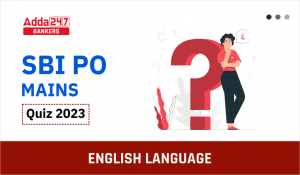
TOPIC: Miscellaneous
Directions (1-5): In
the following passage, some of the words have been left out, each of which is
indicated by a number. Find the suitable word from the options given against
each number and fill up the blanks with appropriate words to make the paragraph
meaningful.
At just past midnight on July 1, 1997 in a glittering and
poignant ceremony, Hong Kong passed from being a jewel of the British empire to
a (1) of a new global power. Hong
Kong people viewed their city’s handover from the UK to China with (2) feelings: apprehension over the
future, joy at a fresh start, sadness at seeing the British go, pride over
returning to their motherland. On the eve of the handover, the stock market
index, a key barometer of Hong Kong’s wealth, (3) at a record 15,200 points and today it hovers near the 21,000
mark. Being a part of a booming China almost guarantees that Hong Kong will
remain (1). But mainland China is a
competitor as well as a partner. China’s new ports, for example, will siphon
trade away from Hong Kong and its
lower labour costs will impact the jobs. However, there is little doubt that
Hong Kong is fortunate to have become a part of China at a time when mainland
China can provide (5) opportunity.
Q1.
(a) component
(b) premises
(c) captive
(d) merger
(e) list
Q2.
(a) flexible
(b) emotional
(c) mixed
(d) changed
(e) negative
Q3.
(a) plunged
(b) rose
(c) valued
(d) climbed
(e) stood
Q4.
(a) marginalised
(b) prosperous
(c) orderly
(d) friendly
(e) poor
Q5.
(a) full
(b) risky
(c) lucky
(d) unfair
(e) immense
Directions
(6-10) :In
the following passage there are blanks, each of which has been numbered. These
numbers are printed below the passage and against each, five words are
suggested, one of which fits the blank appropriately. Find out the appropriate
words.
The
British Cabinet Mission, which had come to India to work out strategy for
transfer of power, left without any success after a stay of more than three
months. It had been a …….(6)……… period of arduous and sustained negotiations
conducted in the …….(7)…….. heat of an Indian summer from which the Cabinet
Mission could have derived mental consolation or physical relief. But they had
not allowed their efforts to flag. They……….(8)……… tirelessly to find a solution
to a near insurmountable problem, ……….(9)………. all kinds of odds and
difficulties. There was Sir Stafford Cripps on the one hand, with his
indefatigable energy and flashes of intellectual genius, and Lord
Pethick-Lawrence on the other, with his …….. (10)……. practical outlook and
undoubted sympathy for Indian aspirations-a combination which might surely have
been expected to produce the results for which everyone had hoped.
Q6. (a) stupendous (b)
remarkable
(c) strenuous (d)
monumental
(e) provocative
Q7. (a) disgusting (b) sweltering
(c) powerful (d)
boiling
(e) simmering
Q8. (a) followed (b)
suggested
(c) extracted (d)
endeavoured
(e) projected
Q9. (a) avoiding (b)
eschewing
(c) observing (d)
maintaining
(e) enduring
Q10. (a) adequately (b)
factually
(c) essentially (d)
prominently
(e) superficially
Directions (11-15): In the following passage, some of the words have been left out, each of
which is indicated by a number. Find the suitable word from the options given
against each number and fill up the blanks with appropriate words to make the
paragraph meaningful.
To emanicipate woman and make her the equal of
man remains an impossibility so long as the woman is shut out from socially
productive labour and restricted to private domestic labour. The emancipation
of woman will only be …11… when she can take part in production on a
large social …12…. and domestic work no longer claims anything but an …13…
of her time. And only now has that become possible through modern large scale ….14…
which does not merely permit the …..15…. range but positively demands.
Q11. (a) probable (b) easy
(c) possible (d)
tuff (e) credible
Q12. (a) measure (b) scale
(c) proportion (d)
measurement (e) segment
Q13. (a) important amount (b) insignificant amount
(c) trivial (d)
amount (e) escape
Q14. (a) enterprise (b) trade
(c) industry (d)
business (e) production
Q15. (a) use (b)
employment
(c) absorption (d)
used (e) application
SOLUTIONS:
S1.
Ans. (a)
S2. Ans. (c)
S3. Ans. (e)
S4. Ans. (b)
S5. Ans. (e)
S6. Ans. (c)
S7. Ans. (b)
S8. Ans. (d)
S9. Ans. (e)
S10. Ans. (c)
S11. Ans. (c)
S12. Ans. (b)
S13. Ans. (b)
S14. Ans. (c)
S15. Ans. (b)




 English Quizzes For SBI PO Mains 2023 - ...
English Quizzes For SBI PO Mains 2023 - ...








